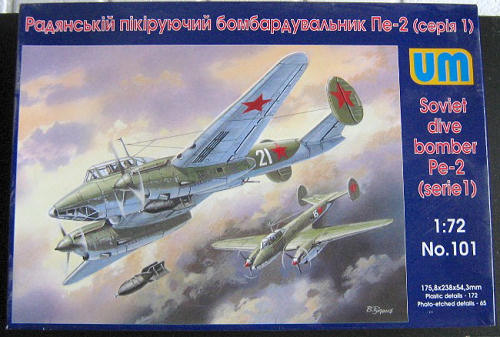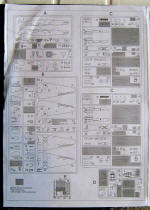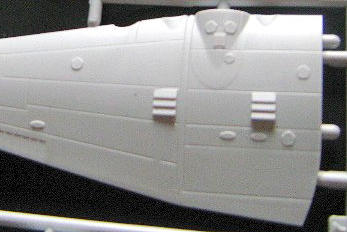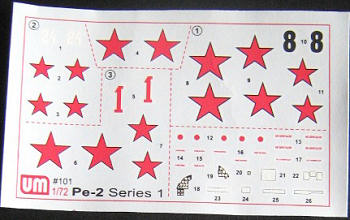UM 1/72 Pe-2 series 1
|
KIT: |
UM 1/72 Pe-2 series 1 |
|
KIT #: |
101 |
|
PRICE: |
$ |
|
DECALS: |
Two options |
|
REVIEWER: |
Nathan Stevens |
|
NOTES: |
Get yours today! |

From kit instructions:
“Pe-2 was the most common Soviet
dive-bomber during WWII.
It was in production from December 1940 to December
1945.
11070 bomber, reconnaissance and training aircraft were
made during this period.
Pe-2 was twin engine monoplane with low positioned
wing and double tail.
Propellers had ability to be positioned.
Wingspan 17.13 m; Length 12.66 m; Take-off weight
(normal) 7700kg, Speed 506 km/hr; Range 1250 km.
Crew of 3 included pilot, navigator and radio
operator, which manned machine gun.
Aircraft had bomb bay inside main fuselage and bomb
bay in rear of each nacelles.
There were also 4 attachment points for external
load.
Normal bomb load was 600kg. Maximum 1000kg.
Dive-bombing was done only from external
attachments.
Power plant consisted of 2 M-105R engines rated at 1100
H.P.
Early PE-2’s had four 7.62mm ShKAS machine guns.
Navigator operated one of them out of the TSS-1
turret.
Two others were permanently fixed in the nose part.
Radio operator manned fourth gun in MV-2 turret
under the fuselage.
Pe-2 participated in combat on Eastern Front from
the first to the last days of war.
They were also used in short campaign in
Far East
to defeat Japan’s
Imperial Army in the summer of 1945.”
 This
is one of at least 3 (that I know of) versions of the Pe-2 that UM has released.
All new tool and of a quality I wasn’t prepared for
until seeing it myself.
The box is even well represented with a sturdy
overlapped bottom half.
All the sprues are bagged together, the decals are
separate though the clear sprue fits nicely in with the decal bag for safe
keeping.
The bulk of the kit is molded in 4 sprues and a small PE
fret is included.
This
is one of at least 3 (that I know of) versions of the Pe-2 that UM has released.
All new tool and of a quality I wasn’t prepared for
until seeing it myself.
The box is even well represented with a sturdy
overlapped bottom half.
All the sprues are bagged together, the decals are
separate though the clear sprue fits nicely in with the decal bag for safe
keeping.
The bulk of the kit is molded in 4 sprues and a small PE
fret is included.
 Panel
lines are engraved though some are a little heavy, similar to older Italari.
There are also a number of prominent ejector pin
marks throughout the fuselage interior and a number of sink marks where the
plastic gets thick such as the rear of the nacelles and wing trailing edges.
The surface has a slight but even texture to it
though not as pronounced as a DML kit.
Panel
lines are engraved though some are a little heavy, similar to older Italari.
There are also a number of prominent ejector pin
marks throughout the fuselage interior and a number of sink marks where the
plastic gets thick such as the rear of the nacelles and wing trailing edges.
The surface has a slight but even texture to it
though not as pronounced as a DML kit.
You get a 24 step instruction
sheet on what amounts to 8 full pages.
Each step is printed large, precise and clear with
callouts for Humbrol colors and generic names.
In most cases the diagrams are bigger than the
actual kit and the paint instructions are given for each part.
The decals are well printed
though largely devoid of color (due to subject matter) and include stencils and
several pieces for the various instrumentation.
They appear rather typical of decals from the region
meaning extremely thin and often translucent.
I’ve generally had great luck with decals of this
type as they settle to the finest of details without the slightest tough of
solvent.
 Clear
parts are quite thick and the bracing is a little heavy but otherwise reasonably
clear with a slightly grainy texture.
Some of the bracing is actually molded to the inside
of
the part though I’m not sure why.
I looks like a dip of future could do a lot for the
glass but I’d really like to see Squadron release a vac replacement.
Clear
parts are quite thick and the bracing is a little heavy but otherwise reasonably
clear with a slightly grainy texture.
Some of the bracing is actually molded to the inside
of
the part though I’m not sure why.
I looks like a dip of future could do a lot for the
glass but I’d really like to see Squadron release a vac replacement.
The instruments are molded as
clear parts with raised detail and an additional decal is given for each of the
various panels.
You get a very complete interior including a fully
loaded and well detailed bomb bay.
There is full interior ribbing in the fuselage,
moveable machine guns and mounts, well detailed cockpit and landing gear, etc.
The tail gear and bay alone account for 9 parts!
The
prop blades are molded separate, landing gear and bomb bay doors can be posed up
or down.
All the access hatches are separate.
Full bomb load inside and out, separate dive fences,
a small fret of PE covers the bomb wing braces and some interior pieces, etc,
etc, etc.
This plus the myriad of extra parts not applied to this
particular version including a second set of nacelles!
Markings are for 2 different aircraft:
HQ of 18th
Close
Range
Bomber Regiment. Kutaisi,
May 1941.
Colors are light green over light blue.
40th Regiment Black Sea Fleet, Summer
1941 in typical typical 3 tone dark gray/light green/light earth over light
blue.
All in all, this was well
above and beyond my expectations.
I bought this version and the 205 series second
hand, still sealed for what I now know was quite a bargain.
Obviously someone didn’t know what they had.
So all you VVS fans like me who are just itching for
new tool, definitive kits of their favorites to replace the aging ceiling
hangers that just aren’t up to par, I’d like you to meet UM!
A toast to them for stepping out of brail scale
armor for a bit and into the mad nitpicking world of brail scale aviation.
You won’t be disappointed, go buy a couple and
convince them we still need Yak-9s, LaGG-3s, La-5s, and so on……………..
Review kit courtesy of sneaky
hide-the-cash-in-a-mayonnaise-jar-so-the-wife-won’t-see-it tactics!
Nathan
Stevens
August 2008
If you would like your product reviewed fairly and quickly, please
contact
me or see other details in the
Note to
Contributors.
Back to the Main Page
Back to the Previews Index Page


 This
is one of at least 3 (that I know of) versions of the Pe-2 that UM has released.
All new tool and of a quality I wasn’t prepared for
until seeing it myself.
The box is even well represented with a sturdy
overlapped bottom half.
All the sprues are bagged together, the decals are
separate though the clear sprue fits nicely in with the decal bag for safe
keeping.
The bulk of the kit is molded in 4 sprues and a small PE
fret is included.
This
is one of at least 3 (that I know of) versions of the Pe-2 that UM has released.
All new tool and of a quality I wasn’t prepared for
until seeing it myself.
The box is even well represented with a sturdy
overlapped bottom half.
All the sprues are bagged together, the decals are
separate though the clear sprue fits nicely in with the decal bag for safe
keeping.
The bulk of the kit is molded in 4 sprues and a small PE
fret is included. Panel
lines are engraved though some are a little heavy, similar to older Italari.
There are also a number of prominent ejector pin
marks throughout the fuselage interior and a number of sink marks where the
plastic gets thick such as the rear of the nacelles and wing trailing edges.
The surface has a slight but even texture to it
though not as pronounced as a DML kit.
Panel
lines are engraved though some are a little heavy, similar to older Italari.
There are also a number of prominent ejector pin
marks throughout the fuselage interior and a number of sink marks where the
plastic gets thick such as the rear of the nacelles and wing trailing edges.
The surface has a slight but even texture to it
though not as pronounced as a DML kit.